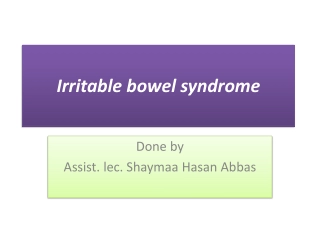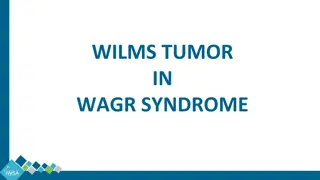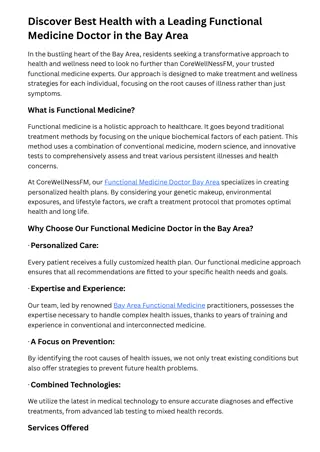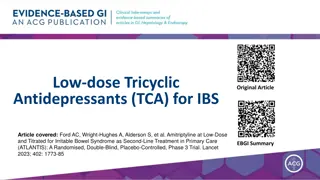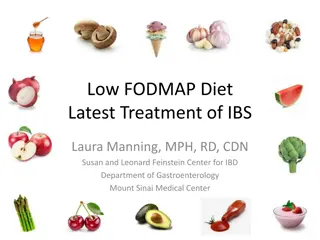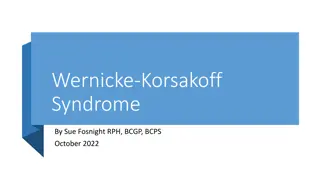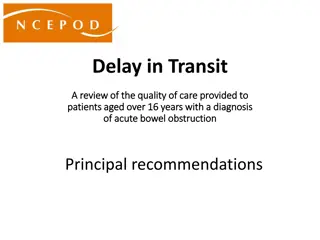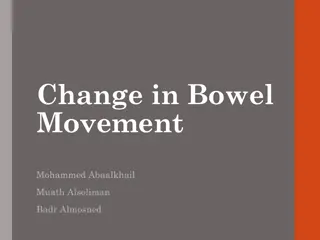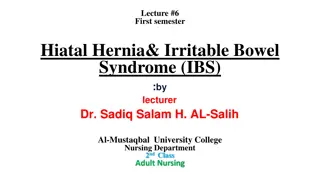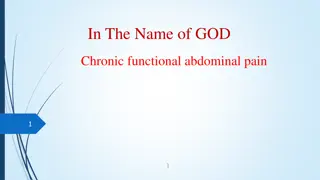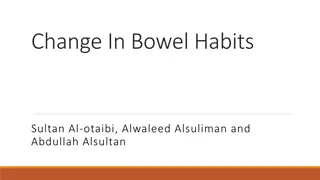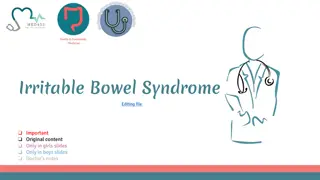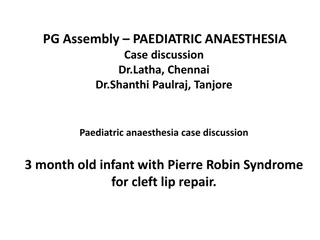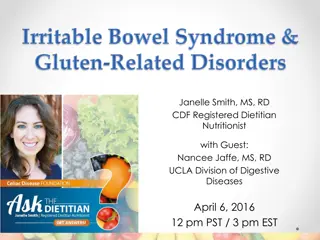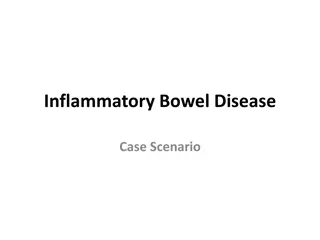Irritable Bowel Syndrome (IBS) - Symptoms, Diagnosis, Management
A common gastrointestinal disorder characterized by chronic abdominal pain and altered bowel habits. This disorder, diagnosed based on Rome III criteria, has no specific markers and is believed to result from various factors affecting motility and food allergy. Learn about the subtypes of IBS, its uncertain pathophysiology involving gastrointestinal motility and visceral hypersensitivity, and the increased sensitivity to gases in IBS patients. Find out how visceral hypersensitivity is detected through distention and bloating studies.
Download Presentation

Please find below an Image/Link to download the presentation.
The content on the website is provided AS IS for your information and personal use only. It may not be sold, licensed, or shared on other websites without obtaining consent from the author.If you encounter any issues during the download, it is possible that the publisher has removed the file from their server.
You are allowed to download the files provided on this website for personal or commercial use, subject to the condition that they are used lawfully. All files are the property of their respective owners.
The content on the website is provided AS IS for your information and personal use only. It may not be sold, licensed, or shared on other websites without obtaining consent from the author.
E N D
Presentation Transcript
c IRRITABLE BOWEL SYNDROME Color code Important doctor notes Notes/extra explanation Success is no accident. It is hard work, perseverance, learning, studying, sacrifice and most of all, love of what you are doing or learning to do. 11). .. (58
OBJECTIVES: By the end of the lecture you should able to: 1) Understand the hypothesis explain the pathophysiology of IBS. 2) Common sign and symptoms 3) Rome III criteria of diagnosis 4) Introduction to management of IBS 2
IRRITABLE BOWEL SYNDROME (IBS) IBS is a gastrointestinal disorder characterized by chronic abdominal pain and altered bowel habits in the absence of any organic cause. All organic investigations are negative (blood tests and endoscopy are negative) There is no specific marker for IBS until now. It is the most commonly diagnosed gastrointestinal condition. 70% of patients who go to the primary clinics because of abdominal pains. It is viewed as a disorder resulting from an interaction among a number of factors some people their main problem is in the motility, & others their main problem is in food allergy. . : 3
SUBTYPES OF IBS IBS with constipation: hard or lumpy stools 25 percent / loose or watery stools <25 percent of bowel movement Mixed IBS: hard or lumpy stools 25 percent / loose or watery stools 25 percent of bowel movements IBS with diarrhea: Unsubtyped IBS: loose or water stools 25 percent / hard or lumpy stools <5 percent of bowl movements insufficient abnormality of stool consistency to meet the above subtypes 4
PATHOPHYSIOLOGY OF IBS The pathophysiology of IBS remains uncertain. Gastrointestinal motility: Visceral hypersensitivity: motor abnormalities of the GI tract are detectable in some patients with IBS Visceral hypersensitivity (increased sensation in response to stimuli) is a frequent finding in IBS patients. Perception in the gastrointestinal (GI) tract results from stimulation of various receptors in the gut wall. Abnormalities observed include: increased frequency and irregularity of luminal contractions diarrhea These receptors transmit signals via afferent neural pathways to the dorsal horn of the spinal cord and ultimately to the brain prolonged transit time in constipation- predominant IBS 5
Notes : People with IBS are more sensitive for gases than the normal ones. It means that IBS patients have the same amount of gases of normal people but their sensitivity to these gases is more. In IBS the GUT is thought to be more sensitive to any stimuli; although this stimuli is not irritating in normal conditions. How we detect Visceral Hypersensitivity? 1. distention 2. Bloating A shape study is performed for IBS PT; The shape study consist of a capsule taken by patient, each capsule contains 24 markers then we take an X-ray. The shape study is commonly used to measure colonic transit with a radiopaque marker. It is recommended for any patient with constipation (major symptom). Note that the rectal distention by retained stools can slow colonic transit, and severely constipated patients should have laxatives &, or enemas to empty the colon before a study of transit. We give the patient the capsule 5 days before the X ray. In the X ray we see where did this shape stopped & know exactly where the hypo-hypermotility happen. Hypo= constipation while hyper = diarrhea. We may do the X- ray daily (we do this usually for research not clinically). 6
PATHOPHYSIOLOGY OF IBS Intestinal inflammation: some patient and not all of them Lymphocytes -Increased numbers of lymphocytes have been reported in the colon and small intestine in patients with IBS . Increase in lymphocyte infiltration in the myenteric plexus in nine patients and neuron degeneration in six patients . These cells release mediators (nitric oxide, histamine and proteases) capable of stimulating the enteric nervous system, leading to abnormal motor and visceral responses within the intestine. Alteration in fecal microflora (normal flora): Change in gut microbiota: emerging data suggest that the fecal microbiota in individuals with IBS differ from healthy controls and varies with the predominant symptom Bacterial overgrowth Any disease of the GIT has an association with it, and it is responsible for its immunity. Probiotics: Bacterial flora. Prebiotics: Food that promotes the growth of the probiotics. There is a study that have been done on mice proves that some bacteria can make people obese! IBS is considered an inflammatory disorder although the cause isn t always post-inflammatory 7
Notes : Microbiota and the bacteria in the GUT can play a major role in our health, as an example obesity. People who have different Microbiota are at higher risk to develop IBS and/ or obesity. When we examine patient with IBS and IBD, some bacteria will be increased in IBS and decreased in IBD. For the obesity they did a study in mice, they toke a bacteria from obese mouse and they give it to a normal mouse. Then they were given the same food, and both developed obesity. 8
PATHOPHYSIOLOGY OF IBS Distention: Post infectious Various studies have shown that in patients with IBS, awareness and pain caused by balloon distention in the intestine are experienced at lower balloon volumes compared with controls A study in Walkerton, Ontario showed that post infections had a little impact on IBS pathophysiology Let s assume that there is a patient who had severe gastroenteritis. It is possible that he/she may suffer IBS symptoms after the infection for 6 weeks period and IBS symptoms will disappear, but some of them will develop chronic IBS. In IBS, the small balloon will cause severe pain, so it s not related to the balloon s size, its related to the sensitivity of the GUT itself (important) Bloating : Food sensitivity About half of patients with IBS (mainly those with constipation) have a measurable increase in abdominal girth associated with bloating (sensation of abdominal fullness) It is unclear whether heightened sensitivity of the intestines to normal sensations is mediated by the local GI nervous system, by central modulation from the brain, or by some combination of the two. Very common, and even siblings have different foods sensitivity. Antigen level are increased afetr a heavy meal (not due to allergy) Psychological dysfunction: Psychosocial factors may influence the expression of IBS. Stress exacerbates the symptoms (nerves hyper-sensitivity) Both bloating and distension cause discomfort, and pain, and have a negative impact on the quality of life for some individuals. The symptoms may be linked with other gas related complaints, such as burping, swallowing air, and passing intestinal gas. . Gas level in IBS is normal or even less than normal, yet it causes severe pain. 9
CLINICAL FEATURES Younger patients and women are more likely to be diagnosed with IBS. 2:1 female predominance in North America In china male are more common to have IBS 1:1 male to female 10
Altered bowel habits It can be changing between constipation and diarrhea in the same patient Chronic abdominal pain Signs and symptoms Upper gastrointestinal symptoms Diarrhea and constipation gastroesophageal reflux, dysphagia, early satiety (feel full quickly while eating), intermittent dyspepsia, nausea, and non-cardiac chest pain, are common in patients with IBS Other gastrointestinal symptoms 11
DIAGNOSTIC APPROACH Patients are identified as having a symptom complex compatible with IBS based upon the Rome III criteria Rome III criteria Recurrent abdominal pain or discomfort at least 3 days per month in the last 3 months associated with 2 or more of the following: Routine laboratory studies (complete blood count, chemistries) are normal in IBS. 1) Improvement with defecation 2) Onset associated with a change in frequency of stool 3) Onset associated with a change in form (appearance) of stool The symptoms may disappear and reoccur NO red flag symptoms: 1) Rectal bleeding 2) Nocturnal or progressive abdominal pain 3) Weight loss (significant 10% in the last 6 months) What is deferent between rome III and IV criteria? Almost the same thing but the main deference are: Rome 3: 3 day/month Rome 4: 1 day/ week Rome 3: Improvement with defecation Rome 4: maybe Improvement with defecation and may get worse. (Important) Not all patients should undergo further investigations but usually we have to investigate patients older than 40 years old because usually they don t have IBS but at they end they may have it. 12
MANAGEMENT IBS is a chronic condition with no known cure. The focus of treatment should be on relief of symptoms and in addressing the patient's concerns. Antispasmodic: Pain. Constipation: Fibers. Diarrhea: Loperamide. Treatment include: Important 1) Therapeutic relationship the physician should inform the patient not to expect any cure but the patient should control the symptoms and increases the quality of life. 2) Patient education To ensure them there is no complication and do not worry 3) Dietary modification Avoid the trigger 4) Psychosocial therapies 5) Medications: Antidepressant medication (the last choice, only if all the previous ways failed to improve their symptoms. Ensure the patient that he/she don t have depression but the perception of this drug is in order to decrease neuronal sensitivity in their gut. 13
SUMMARY Definition It is a gastrointestinal disorder characterized by chronic abdominal pain and altered bowel habits in the absence of any organic cause Pathophysiology 1. GASTROINTESTINAL MOTILITY: Motor abnormalities of the GI tract include: i. increased frequency and irregularity of luminal contractions ii. prolonged transit time in constipation-predominant IBS VISCERAL HYPERSENSITIVITY: distention and bloating INTESTINAL INFLAMMATION: Increased numbers of lymphocytes in the colon and small intestine. ALTERATION IN FECAL MICROFLORA(Change in gut microbiota - bacterial overgrowth) POSTINFECTIOUS FOOD SENSITIVITY PSYCHOSOCIAL DYSFUNCTION 1. 2. 3. 4. 5. 6. Younger patients and women are more likely to be diagnosed with IBS. Clinical features Signs and symptoms Chronic abdominal pain Altered bowel habits Diarrhea Constipation Upper gastrointestinal symptoms: gastroesophageal reflux, dysphagia, early satiety, intermittent dyspepsia, nausea, and non-cardiac chest pain, are common in patients with IBS Diagnostic criteria Recurrent abdominal pain or discomfort at least 3 days per month in the last 3 months associated with 2 or more of the following: Improvement with defecation Onset associated with a change in frequency of stool Onset associated with a change in form (appearance) of stool (Rome III criteria) 14
- - - - IBS with constipation hard or lumpy stools 25 percent / loose or watery stools <25 percent of bowel movements IBS with diarrhea: loose or water stools 25 percent / hard or lumpy stools <5 percent of bowel movements Mixed IBS hard or lumpy stools 25 percent / loose or watery stools 25 percent of bowel movements Unsubtyped IBS insufficient abnormality of stool consistency to meet the above subtypes Subtypes Patients are identified as having a symptom complex compatible with IBS based upon the Rome III criteria Routine laboratory studies (complete blood count, chemistries) are normal in IBS. NO red flag symptoms: -Rectal bleeding -Nocturnal or progressive abdominal pain -Weight loss Diagnostic approach It has no known cure but The focus of treatment should be on relief of symptoms and in addressing the Patient s concerns. 1.Therapeutic relationship 2.Patient education 3.Dietary modification 4.Psychosocial therapies 5.Medications: Antidepressant medication Management 15
MCQs: Check your understanding 5-Which one of the following is not considered as red flag symptom : 1-Which one of the following is the most commonly diagnosed gastrointestinal condition: A-Rectal bleeding A-IBD B- Bloating B-IBS C-Progressive abdominal pain C- Colitis D-Weight loss D- Pancreatitis 2- Which one of the following in not a symptom of IBS: 6- Increased numbers of which one of the following cells have been reported in the colon and small intestine in patients with IBS: A-Diarrhea A-Macrophages B- Dyspepsia B-Monocytes C- Constipation C-Lymphocytes D- Rectal bleeding D- Neutrophils 3-In china female are more common to have IBS than male: 7- Which one of the following used to manage the symptoms for a patient with IBS: A-True B-False A-Dietary modification 4-Which CRITERIA is used in diagnosis for IBS: B-Antidepressant medication 7-D A- Rome I criteria C-Psychosocial therapies 6-C B-Rome II criteria 5-B D-All of the above 4-C C-Rome III criteria 3-B 2-D D-Rome IIII criteria 1-B 16 Answers:
c Leaders : TEAM MEMBERS: Naif alziyadi & Jawaher alkhayyal Zaina alkaff Reema alshayie Lama altamimi Hanin Bashikh Alaa alaqeel Shahad alanzan 82 Please check our editing file: https://docs.google.com/presentation/d/1-ToRZ75K6Bva- _wmwUUdohnVPlDvh368MvwfT0XmbXw References : Girls & boys slides medicine436@gmail.com @medicine436 Videos: 17 https://www.youtube.com/watch?v=9f5wxYW0Z3k https://www.youtube.com/watch?v=eKLqFnAmK6c 3:13**highly recommended**


